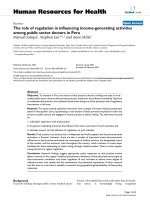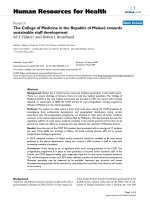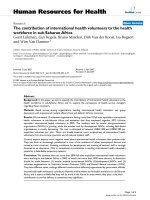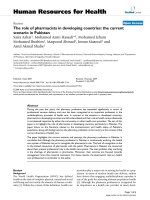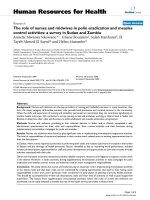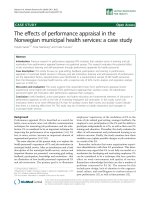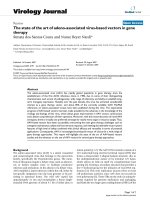Báo cáo sinh học: "The future of artemisinins: natural, synthetic or recombinant" potx
Bạn đang xem bản rút gọn của tài liệu. Xem và tải ngay bản đầy đủ của tài liệu tại đây (501.2 KB, 5 trang )
Minireview
TThhee ffuuttuurree ooff aarrtteemmiissiinniinnss:: nnaattuurraall,, ssyynntthheettiicc oorr rreeccoommbbiinnaanntt??
Marcel Hommel
Address: Institut Pasteur, 25-28 rue du Dr Roux, Paris 75724 Cedex 15, France. Email:
Artemisinin, derived from sweet wormwood, Artemisia annua,
is the spearhead of anti-malarial chemotherapy. In 2004, the
World Health Organization (WHO) recommendation that
artemisinin-based combination therapy (ACT) should be the
norm for the treatment of falciparum malaria in most
endemic countries came into effect [1]. Financial backing for
this treatment from the Global Fund for AIDS, Tuberculosis
and Malaria and other international sponsors has led to a
massive increase in the demand for artemisinin, but with an
estimated 12-14 months lead-time from planting of A. annua
to artemisinin extraction, stepping-up production (or adjust-
ing to fluctuations in demand) from the plant is not simple,
and alternative means of producing the raw material by
complete chemical synthesis or recombinant technologies are
being explored. It would, however, be naive to believe that the
cost of the raw material is the main determinant of the cost of
a drug. This article looks at issues surrounding the production
of artemisinins, particularly in the light of a recent paper by
Jay Keasling and colleagues (Ro et al. [2]) in BMC
Biotechnology, which describes a way of improving the yield of
the precursor, artemisinic acid, in genetically engineered yeast.
TThhee cchheemmiissttrryy aanndd tthheerraappeeuuttiicc aapppplliiccaattiioonnss ooff
aarrtteemmiissiinniinnss
Artemisinin (qinghaosu) was discovered in 1971 by Chinese
scientists looking at the anti-malarial properties of herbs in
the traditional Chinese pharmacopeia: A. annua had been
used as an antipyretic tea for more than 2,000 years.
Although no longer used as a drug itself, artemisinin is the
starting compound for a class of highly active anti-malarials,
which are produced by chemical modification of arte-
misinin. These ‘artemisinins’ include dihydroartemisinin,
artemether and artesunate, the latter being a particularly
interesting derivative because it is water-soluble and can be
given intravenously.
Artemisinin is a sesquiterpene lactone containing an endo-
peroxide bridge that is considered essential to its anti-
malarial action: haem-catalyzed cleavage of the peroxide
generates unstable free radicals to which malaria parasites are
particularly sensitive [3]. Although the peroxide activity is
necessary, it may not be sufficient to explain the mechanism
of action of artemisin, and alternative hypotheses might need
to be considered. Specific interactions of artemisinin with
parasite proteins, such as the translationally controlled tumor
protein (TCTP) and the parasite ortholog of sarco-
plasmic/endoplasmic-reticulum Ca
2+
-ATPase (PfATP6), have
been reported, but the interaction with haem within the
parasite-containing vacuole inside the host cell is of special
interest. The conversion of toxic haem into non-toxic
hemozoin, or malarial pigment, is crucial for parasite
survival, and the inhibition of hemozoin formation is a
major mechanism of action of many existing anti-malarials,
AAbbssttrraacctt
Artemisinins are the most important anti-malarial drugs in use today, but are more costly
than previous anti-malarials and production and price tend to fluctuate. Alternative ways of
producing artemisinins are discussed here in the light of a recent paper in
BMC Biotechnology
on improving the yield of the precursor, artemisinic acid, in genetically engineered yeast.
Journal of Biology
2008,
77::
38
Published: 15 December 2008
Journal of Biology
2008,
77::
38 (doi:10.1186/jbiol101)
The electronic version of this article is the complete one and can be
found online at />© 2008 BioMed Central Ltd
including chloroquine. Kannan et al. [4] have shown that
there is a potent interaction between protein-bound haem
in hemoglobin and artemisinin, with the formation of
‘hemarts’, which bind to PfHRP2 (Plasmodium falciparum
histidine-rich protein-2) and inhibit hemozoin formation.
Artemisinins have broad stage specificity in their anti-
malarial action, killing all asexual stages, as well as gameto-
cytes, but have no effect on the exo-erythrocytic stages.
Where artemisinins differ from other anti-malarials is that
they kill young trophozoites (‘ring’ stage); (Figure 1). As a
result, artemisins are rapidly effective and reduce the number
of late trophozoites in the capillaries. There is a rapid
clinical improvement in patients and reduction of the risk
of severe complications. The effect on gametocytes means
less efficient transmission of the parasite to the mosquito
vector, which potentially contributes to an interruption of
transmission to humans and also reduces the risk of dis-
persion of any drug-resistant mutants. Recent field studies
have shown that artemisinin treatment significantly reduced
gametocyte carriage compared with other drugs, an effect
that was variable from one geographical area to another,
depending on the level of malaria endemicity and access to
treatment [5].
Monotherapy with artemisinins has now mostly been
abandoned. WHO finally agreed, after years of lobbying, to
recommend the use of a three-day regimen of combination
therapy - that is, artemisinin together with a partner drug -
for the treatment of uncomplicated malaria. Because of their
different kinetics of action, not only does one drug protect
the other from provoking resistance, but as artemisinins
effectively kill most of the parasites in the first few hours of
treatment, the partner drug has a better chance of being
effective against the remaining few [6]. Two fixed-dose drug
combinations are available, artemether-lumefantrine (Coartem
or Riamet) and artesunate-amodiaquine (Coarsucam or
ASAQ): these have broadly comparable efficacy and the
fixed dose has many advantages over other presentations,
such as blister-packs. Intravenous artesunate acts signifi-
catively faster than intravenous quinine, in terms of both
parasite clearance and clinical improvement, and there is
now a strong case for recommending parenteral artesunate
instead of quinine for the treatment for severe malaria [7].
As well as their anti-malarial activity, artemisinins are
effective against a number of other parasitic diseases,
particularly schistosomiasis, and there is now growing
experimental evidence that they may potentially be useful
against cancer, especially as their mechanism of action is so
different from that of other anti-cancer drugs [8].
HHooww mmuucchh aarrtteemmiissiinniinn iiss nneeeeddeedd??
This question can be rephrased as ‘how many cases of malaria
need to be treated with ACT every year?’ and is difficult to
answer. Estimates of the true prevalence of malaria worldwide
vary greatly because they are not based on accurate reporting
at the country level. In most endemic countries, treatment is
given on a presumptive diagnosis, sometimes using a clinical
algorithm with the presence of fever as a key factor but
generally without laboratory confirmation. At best this
approach is only 50% reliable (and less than 5% reliable in
areas of low endemicity). In Africa alone, various estimates
suggest that there are 215 to 375 million malaria episodes per
year, and, on the basis of usage of the ‘old anti-malarials’,
Kindermans et al. [9] calculated projected drug consumption
to be between 113 and 314 million adult-equivalent
treatment courses per year. In 2004, the forecast was for 60
million treatment courses in 2005 and 130 million in 2006.
Although these figures already underestimated actual medical
need, the amount of ACT delivered in Africa in 2006 was even
lower (less than 100 million treatment courses). Forecasting
artemisinin needs is clearly a highly complex process.
Underproduction leads to shortages and inflated prices, whereas
overproduction leads to rapid expiry of the drugs and potential
losses by suppliers, as outlined by Cohen and colleagues [10],
who looked at forecasting issues from a funding agency angle.
38.2
Journal of Biology
2008, Volume 7, Article 38 Hommel />Journal of Biology
2008,
77::
38
FFiigguurree 11
Artemisinins kill parasites more effectively and at an earlier stage in the
erythrocytic part of its life cycle than most of the other anti-malarial
currently in use. They also kill the gametocyte stage and may contribute
to interrupting transmission. They do not work on the exo-erythrocytic
forms, hence do not prevent relapses in
P. vivax
or
P. ovale
.
trophozoite
NNaattuurraall aarrtteemmiissiinniinnss
A. annua is an annual plant, growing to 150 cm tall and
found wild in many countries (Figure 2). Production of A.
annua is dominated by China and Vietnam, but it is also
now grown in the highlands of Tanzania, South Africa,
India and Madagascar. The active pharmaceutical ingredient
(API) or ‘raw artemisinin’ is extracted from the leaves, just
before the plant flowers, and from planting to extraction
takes more than 12 months. Soil, climate, altitude and
grower’s know-how can affect the content of artemisinin
substantially. Early problems with scaling-up production
have, to a large extent, been solved by selection of plants for
high artemisinin content and adaptation to the environ-
ment in which they are to be grown. Further improvement
in yield and quality may be possible by further selection,
like that being undertaken by Artemisinin Enterprise at the
University of York, in collaboration with the Swiss not-for-
profit organization Médiplant, using fast-track genetic breed-
ing technologies. Hydroponics and in vitro plant culture are
other interesting options, which have not yet confirmed
their potential.
There are claims that the plant simply infused in water
could provide a ‘home-grown’ malaria treatment in rural
areas in the tropics. Although trials of such a tea yielded
higher than expected amounts of artemisinin, and the
plasma concentration achieved by consumption of the tea
was compatible with an effective anti-malarial activity
(reviewed in [11]), the same trials showed considerable
variation in artemisinin content from one batch of plants to
another and a high rate of malaria recrudescence. It would
be wrong to promote the use of wormwood tea as a ‘cheap’
alternative to drug treatment. This use would certainly
increase the risk of resistance emerging and A. annua does
not grow in the tropical environment where malaria is
endemic and cannot, therefore, be ‘home-grown’ where it
would be most needed.
Raw artemisinin is extracted with solvents, such as hexane,
followed by chromatography to improve purity. The extracts
usually contain both artemisinin and its precursor,
artemisinic acid, which can later be transformed into
artemisinin. On average, 40 hectares (ha) of land produce a
tonne of dried leaves, which can yield 6 kg of artemisinin.
The production of 100 million adult treatment courses
would require about 10,000 ha of A. annua plantations.
Despite the relatively low yield, the exploitation of A. annua
is commercially viable as long as the price of API is suf-
ficiently stable. In reality, there have been massive fluctua-
tions since 2004, with prices varying between US$1,600/kg,
when there was a world shortage following the WHO
recommendation, to as low as $150 at the end of 2007,
when there was a glut. This see-saw effect, which is a direct
result of the problems in forecasting demand, is not sustain-
able in the long term and efforts are being made to stabilize
the market [12].
Even more than cost, the difficulty in coping with fluctua-
tions in the supply of raw artemisinin of plant origin is the
major pressure for a switch to alternative sources. It is
considerably easier to cope with ups and downs in demand
by switching on a chemical synthesis or a fermentation
process than by dealing with the long lead-time of plantations.
The drugs currently used as components of ACT are no
longer ‘natural’ artemisinins, as extraction from the plant is
followed by a semi-synthetic process to transform the
molecule first into dihydroartemisinin, then into artemether
or artesunate. Another alternative, which is, surprisingly, not
used industrially outside China, is to focus the extraction
/>Journal of Biology
2008, Volume 7, Article 38 Hommel 38.3
Journal of Biology
2008,
77::
38
FFiigguurree 22
Artemisia annua
plant. USDA-NRCS PLANTS Database, NL Britton and
A Brown. 1913. Illustrated flora of the northern states and Canada. Vol.
3: 526.
process entirely on artemisinic acid, which being 8-10 times
more abundant in the plant gives much better yields, and
then to use one of the conversion processes described to
transform it into artemisinin.
AAlltteerrnnaattiivveess ttoo pprroodduuccttiioonn ffrroomm ppllaannttss
The full chemical synthesis of artemisinin was achieved in
1983, but is too complex and expensive for commerciali-
zation. The alternative is the development of fully synthetic
peroxides (trioxanes or trioxolanes). These molecules have
similarities with artemisinin, including the key endoper-
oxide bridge, but their mode of action is different in many
ways. Of the many peroxides tested, one trioxolane showed
promise (OZ277/RBx11160 or Arterolane) [13]: it was
highly potent against P. falciparum in vitro and its synthesis
was sufficiently simple for industrial scale-up. The drug
proved too unstable in vivo, however, and clinical trials were
stopped before phase III. More stable molecules are in
development and a hybrid trioxane-aminoquinoline (tri-
oxaquine) [14] may achieve the looked-for objective of a
fully synthetic anti-malarial peroxide.
Microbial genetic engineering is an attractive alternative to
chemical synthesis. Artemisinic acid can be produced in
Escherichia coli and, even more effectively, in Saccharomyces
cerevisiae [15], following pioneering work by Keasling and
colleagues, who transferred 10 A. annua genes into E. coli to
create an almost ‘plant-like’ environment in the bacteria.
Their approach circumvents some of the previous problems
of engineering the precursors (amorphadiene or artemisinic
acid) or enzymes (amorphadiene oxidase) involved in the
artemisinin biosynthetic pathway. Expression levels in yeast
are still insufficient for industrialized scale-up, but the new
publication by the group [2] describes a further improve-
ment in production in yeast (with a 10 times higher yield)
by using a high-copy plasmid system. This opens the way
for a production process that would completely bypass the
need for plantations of A. annua, and in which the yeast-
produced precursor would be chemically converted to
artemisinin as indicated above. There are still a few hurdles
to clear, including confirmation of structural and functional
identity between the natural and engineered molecules.
TThhee tthhrreeaatt ooff ddrruugg rreessiissttaannccee
We know from past experience that, once emerged,
resistance of the malaria parasite to a drug spreads fast:
chloroquine resistance emerged in the late 1950s in South-
East Asia, was reported for the first time in East Africa in the
1970s, and has since invaded the entire African continent. It
is probably inevitable that mutants resistant to artemisinins
will eventually emerge and, if they do, this will probably
happen in South-East Asia, where artemisinins have been used
extensively as monotherapy for nearly 20 years. Studies from
the Thai-Cambodian border, and more recently from South
Cambodia, have already shown reduced susceptibility, as well
as treatment failure rates with ACT exceeding 10%, which is
higher than anywhere else. This area is now carefully observed
by the scientific community, but monitoring is difficult in the
absence of reliable molecular markers for artemisinin
resistance, and relies on in vivo and in vitro sensitivity testing,
which is cumbersome. As long as there is no resistance to the
partner drug, it is usually assumed that the risk of resistance
spreading will remain low. It is important that malaria
treatment be most carefully controlled in South-East Asia,
banning monotherapy (which is still frequent), ensuring
access to prompt ACT treatment with good-quality drugs and,
whenever possible, treating asymptomatic carriers, who
contribute to the spread of resistance.
In conclusion, even when synthetic or recombinant
artemisinin-like molecules have gone through preliminary
tests to confirm their worth, there will still be a long way to go
- at least five to six years and millions of dollars - before they
will be available as drugs. It is, therefore, likely that A. annua
will continue to be the main source of artemisinin for the
foreseable future. It is true that the effectiveness of increasing
worldwide utilization of ACT relies on a sustainable supply of
artemisinin, preferably at an affordable price. It is also true
that limited access to ACT, as is still the case in many African
countries, is not necessarily due to a shortage of raw material,
or insufficient production, or even the high cost of the drug. It
is more often a poor coordination of distribution at country
level. Major funding organizations, including the Global
Fund, have begun to understand that, in order to be effective,
they not only have to deal with the cost of the drug, but must
also strengthen health-system infrastructure and improve
provision for diagnosis and treatment in the field. Keeping the
cost of the drug down means not only ensuring a sustainable
supply of the raw material, but also putting pressure on
manufacturers to keep the price of the final drug reasonable;
both of which could be achieved by using subsidies to pre-
order drugs years in advance. This, however, assumes that
forecasting need becomes much better than is currently
feasible. The recent endorsement by the 2008 Roll Back
Malaria Action Plan of the Affordable Medicines Facility for
malaria (AMFm) initiative, a proposed $1.9 billion financial
resource, is likely to have a major role in improving access to
the drug at all levels.
RReeffeerreenncceess
1. World Heath Organization:
Guidelines for the Treatment of
Malaria.
WHO/HTM/MAL/2006.1108.
2. Ro DK, Ouellet M, Paradise EM, Burd H, Eng D, Paddon CJ,
Newman JD, Keasling JD:
IInndduuccttiioonn ooff mmuullttiippllee pplleeiioottrrooppiicc ddrruugg
38.4
Journal of Biology
2008, Volume 7, Article 38 Hommel />Journal of Biology
2008,
77::
38
rreessiissttaannccee ggeenneess iinn yyeeaasstt eennggiinneeeerreedd ttoo pprroodduuccee aann iinnccrreeaasseedd lleevveell
ooff aannttii mmaallaarriiaall ddrruugg pprreeccuurrssoorr,, aarrtteemmiissiinniicc aacciidd
BMC Biotechnol
2008,
88::
83.
3. Meshnick SR, Jefford CW, Posner GH, Avery MA, Peters W:
SSeeccoonndd ggeenneerraattiioonn aannttiimmaallaarriiaall eennddooppeerrooxxiiddeess
Parasitol Today
1996,
1122::
79-82.
4. Kannan R, Kumar K, Sahal D, Kukreti K, Chauhan VS:
RReeaaccttiioonn ooff
aarrtteemmiissiinniinn wwiitthh hhaaeemmoogglloobbiinn:: iimmpplliiccaattiioonnss ffoorr aannttiimmaallaarriiaall aaccttiivviittyy
Biochem J
2005,
338855::
409-418.
5. Stepniewska K, Price RN, Sutherland CJ, Drakeley CJ, von Seidlein
L, Nosten F, White NJ:
PPllaassmmooddiiuumm ffaallcciippaarruumm
ggaammeettooccyyttee ddyynnaamm
iiccss iinn aarreeaass ooff ddiiffffeerreenntt mmaallaarriiaa eennddeemmiicciittyy
Malar J
2008,
77::
249.
6. White NJ:
QQiinngghhaaoossuu:: tthhee pprriiccee ooff ssuucccceessss
Science
2008,
332200::
330-
334.
7. Dondorp A, Nosten F, Stepniewska K, Day N, White N, South
East Asian Quinine Artesunate Malaria Trial (SEAQUAMAT)
group:
AArrtteessuunnaattee vveerrssuuss qquuiinniinnee ffoorr ttrreeaattmmeenntt ooff sseevveerree ffaallccii
ppaarruumm mmaallaarriiaa:: aa rraannddoommiisseedd ttrriiaal
l
Lancet
2005,
336666::
717-725.
8. Krishna S, Bustamante L, Haynes RK, Staines HM:
AArrtteemmiissiinniinnss::
tthheeiirr ggrroowwiinngg iimmppoorrttaannccee iinn mmeeddiicciinnee
Trends Pharmacol Sci
2008,
2299::
520-527.
9. Kindermans JM, Vandenbergh D, Vreeke E, Olliaro P, D’Altilia JP:
EEssttiimmaattiinngg aannttiimmaallaarriiaall ddrruuggss ccoonnssuummppttiioonn iinn AAffrriiccaa bbeeffoorree tthhee
sswwiittcchh ttoo aarrtteemmiissiinniinn bbaasseedd ccoommbbiinnaattiioonn tthheerraappiieess ((AACCTTss))
Malar J
2007,
66::
91.
10. Cohen JM, Singh I, O’Brien ME:
PPrreeddiiccttiinngg GGlloobbaall FFuunndd ggrraanntt ddiiss
bbuurrsseemmeennttss ffoorr pprrooccuurreemmeenntt ooff aarrtteemmiissiinniinn bbaasseedd ccoommbbiinnaattiioonn
tthheerraappiieess
Malar J
2008,
77::
200.
11. De Ridder S, van der Kooy F, Verpoorte R:
AArrtteemmiissiiaa aannnnuuaa
aass aa
sseellff rreelliiaanntt ttrreeaattmmeenntt ffoorr mmaallaarriiaa iinn ddeevveellooppiinngg ccoouunnttrriieess
J
Ethnopharmacol
2008,
112200::
302-314.
12. Kindermans JM, Pilloy J, Olliaro P, Gomes M:
EEnnssuurriinngg ssuussttaaiinneedd
AACCTT pprroodduuccttiioonn aanndd rreelliiaabbllee aarrtteemmiissiinniinn ssuuppppllyy
Malar J
2007,
66::
125.
13. Vennerstrom JL, Arbe-Barnes S, Brun R, Charman SA, Chiu FC,
Chollet J, Dong Y, Dorn A, Hunziker D, Matile H, McIntosh K,
Padmanilayam M, Santo TJ, Scheurer C, Scorneaux B, Tang Y,
Urwyler H, Wittlin S, Charman WN:
IIddeennttiiffiiccaattiioonn ooff aann aannttiimmaallaarr
iiaall ssyynntthheettiicc ttrriiooxxoollaannee ddrruugg ddeevveellooppmmeenntt ccaannddiiddaattee
Nature
2004,
443300::
900-904.
14. Benoit-Vical F, Lelièvre J, Berry A, Deymier C, Dechy-Cabaret O,
Cazelles J, Loup C, Robert A, Magnaval JF, Meunier B:
TTrriiooxx
aaqquuiinneess aarree nneeww aannttiimmaallaarriiaall aaggeennttss aaccttiivvee oonn aallll eerryytthhrrooccyyttiicc
ffoorrmmss,, iinncclluuddiinngg ggaammeettooccyytteess
Antimicrob Agents Chemother
2007,
5511::
1463-1472.
15. Ro DK, Paradise EM, Ouellet M, Fisher KJ, Newman KL, Ndungu
JM, Ho KA, Eachus RA, Ham TS, Kirby J, Chang MC, Withers ST,
Shiba Y, Sarpong R, Keasling JD:
PPrroodduuccttiioonn ooff tthhee aannttiimmaallaarriiaall
ddrruugg pprreeccuurrssoorr aarrtteemmiissiinniicc aacciidd iinn eennggiinneeeerreedd yyeeaasstt
Nature
2006,
444400::
940-943.
/>Journal of Biology
2008, Volume 7, Article 38 Hommel 38.5
Journal of Biology
2008,
77::
38
